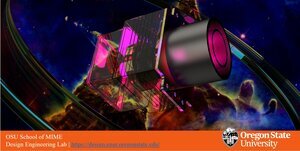
The Deep Space Propulsion Group (DSPG), led by Dr. Camburn, works to develop tools, technology, and design processes that expand access to space through simple and cutting edge designs. Only recently founded in 2019, DSPG is still in the early stages of project planning and preliminary design. Over the next 5 years, DSPG aims to develop an in-space vehicle capable of performing a yet-to-be-determined task. To study an area of space technology that is cheaper to manufacture and has the potential to change the way vehicles travel in space, a high-power electric engine will be incorporated within the design of the vehicle. This method of propulsion technology has yet to be perfected, which provides the team with a tremendous opportunity to develop diverse and innovative engine designs.
Ion propulsion systems must be tested in a high vacuum environment. In order to simulate an in-space environment, this year’s CAPSTONE Team worked to Design, Build, and Manufacture a capable Test Chamber. As DSPG begins the engine prototyping phase, the test chamber will be used to explore alternative and potentially novel engine designs in a rapid and efficient manner. The testing environment includes a functional vacuum chamber, vacuum system, engine mount, data acquisition system, gas supply, and command module. Along with design, the scope of this project also includes the prototyping of the engine mount, gas supply, and vacuum-system support structure. Lastly, the DSPG Capstone team has written testing protocols for exploratory, development, and verification purposes.
The Data Acquisition (DAQ) system, as the name suggests, is used to acquire data from the Vacuum Chamber. This is the central nervous system. Data includes the various environmental parameters inside the chamber and vacuum system. Additionally, this system must be able to send signals to various relays in order to establish control over input variables.
| Attachment | Size |
|---|---|
| 1.27 MB |

